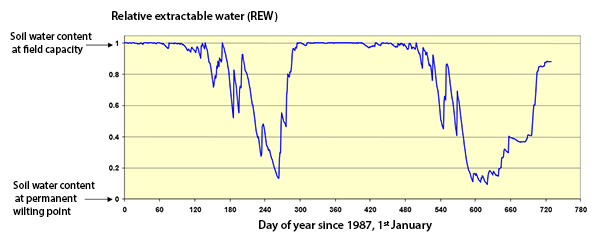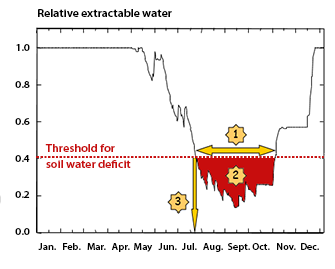
BILJOU
Forest water balance model
 - Silva Joint Research Unit
- Silva Joint Research Unit
Ecophysiological drought indicators
How are these defined?
Edaphic drought refers in particular to soil conditions, water content or soil drought, as opposed to atmospheric drought (e.g. quantified by air vapour pressure deficit). These two types of drought have an affect on trees functioning through stomatal regulation.
Edaphic or soil drought can be defined in different ways by considering :
- soil water status, characterized by existing water content or water potential, or
- soil water content available for plants.
In the latter case, the soil water deficit is characterized by the water reserve relative to the maximum capacity level or to thresholds defined by any physiological consequences of water shortage.
Ecophysiologists (foresters and agronomists) often describe the soil water reserve in terms of relative value using the term REW (Relative Extractable Water). This is a dimensionless number calculated for a given day (j) using the formula: REWj = (Rj – Rmin) / RU In which:
- Rj is the soil water content on a given day (j) in mm, calculated using the rooting depth
- Rmin reprensents the minimum soil water content observed at the permanent wilting point (pF = 4.2), also expressed in mm at the same depth
- RU represents the total amount of extractable soil water in the rooted zone, measured in mm, and is itself the difference between the soil water reserve at field capacity and at the permanent wilting point (see the page soil water reserve).
REW is therefore a variable between 1, when the soil is at field capacity and 0, when the soil is at the wilting point. This REW variable is available by using the Biljou© daily simulation calculations. The figure below shows an example how relative extractable water levels can evolve over a two year period.

Evolving variations of relative extractable water over a two year period
Since the 1980s, the filling state of the soil water reservoir has been characterized by this variable. Numerous studies since then have been carried out on different tree species, under various climatic and soil conditions, showing a threshold below which stomatal conductance (or canopy conductance for a stand) can regulate a trees water consumption. This threshold is equal to 0.4 (see the page Water balance modelling). We have also shown that the radial growth of oak, beech or Douglas-fir stopped when the REW dropped below this threshold.
 Illustration of three ecophysiological edaphic drought indicators described below.
Illustration of three ecophysiological edaphic drought indicators described below.
- The water deficit duration (NJstress in the annual calculation file) represents the number of days when REW is lower than 0.4. This number of days is calculated during the leafy phenophase (see the page Phenology and Leaf Area Index) for deciduous trees and throughout the year for evergreens.
- The soil water stress index (noted in Istress in the annual calculation file) incorporates both the duration and intensity of soil water deficit below the threshold of 0.4. The water deficit, a dimensionless number, is calculated as being the sum of daily differences between the REW and the 0.4 value divided by 0.4.
- The date water deficit begins (noted DEBstress in the annual calculations) marks the first day REW drops below 0.4.
Why use this relative value?
Water availability in the soil for plants to access will obviously depend on the size of the available reserve, i.e. the depth of rooting and the physical soil properties. In the same climate, it is therefore difficult to directly compare the severity of the water shortage suffered by trees if they grow in soils with different available water reserves. This comparison is possible if it is used to express the reservoirs content level: whether the reserve is large or small, the tree will have difficulty extracting water from the soil if a certain amount of retained water remains available.
What does REW threshold to 0.4 signify?
Trees implement their regulatory systems (stomatal closure) when the suction needed to extract water from the soil becomes too strong. This suction is expressed in units of water potential (unit MPa). However, the degree to which water is absorbable depends on the size of the pores in which water is stored. As such, water can be extracted through large pores with requiring less suction force; this soil water status corresponds to a REW between 0.4 and 1. By contrast, when REW drops below 0.4, the large pores are empty. Available water for trees is at this point only contained in the micropores and its extraction requires stronger force.
Useful references
![]() Granier A, Badeau V, Bréda N (1995) Modélisation du bilan hydrique des peuplements forestiers. Revue Forestière Française, XlVII: 59-68.
Granier A, Badeau V, Bréda N (1995) Modélisation du bilan hydrique des peuplements forestiers. Revue Forestière Française, XlVII: 59-68.
![]() Bernier P, Bréda N, Granier A, Raulier F, Mathieu F (2002) Validation of a canopy gas exchange model and derivation of a soil water modifier
for transpiration for sugar maple (Acer saccharum Marsh.) using sap flow density measurements. Forest Ecology and Management 163(1): 185-196.
Bernier P, Bréda N, Granier A, Raulier F, Mathieu F (2002) Validation of a canopy gas exchange model and derivation of a soil water modifier
for transpiration for sugar maple (Acer saccharum Marsh.) using sap flow density measurements. Forest Ecology and Management 163(1): 185-196.
![]() Granier A, Bréda N, Biron P, Villette S (1999) A lumped water balance model to evaluate duration and intensity of drought constraints
in forest stands. Ecological Modelling 116: 269-283.
Granier A, Bréda N, Biron P, Villette S (1999) A lumped water balance model to evaluate duration and intensity of drought constraints
in forest stands. Ecological Modelling 116: 269-283.
![]() Sadras V O, Milroy S P (1996) Soil-water thresholds for the responses of leaf expansion and gas exchange: A review. Field Crops
Research 47: 2-3.
Sadras V O, Milroy S P (1996) Soil-water thresholds for the responses of leaf expansion and gas exchange: A review. Field Crops
Research 47: 2-3.

